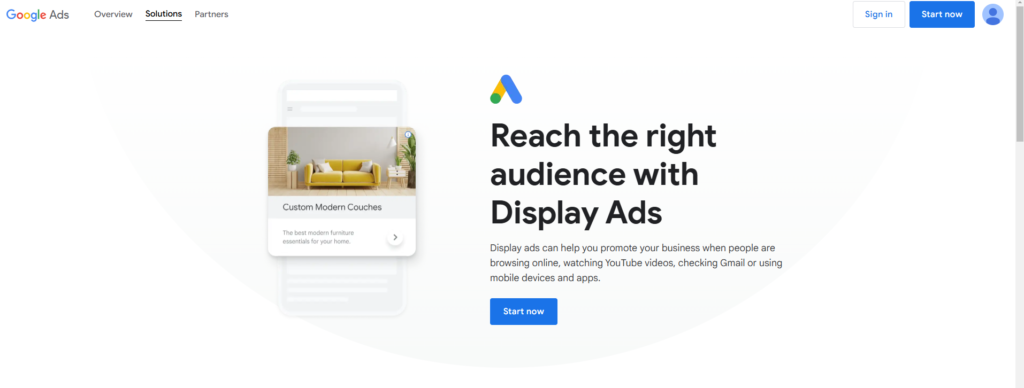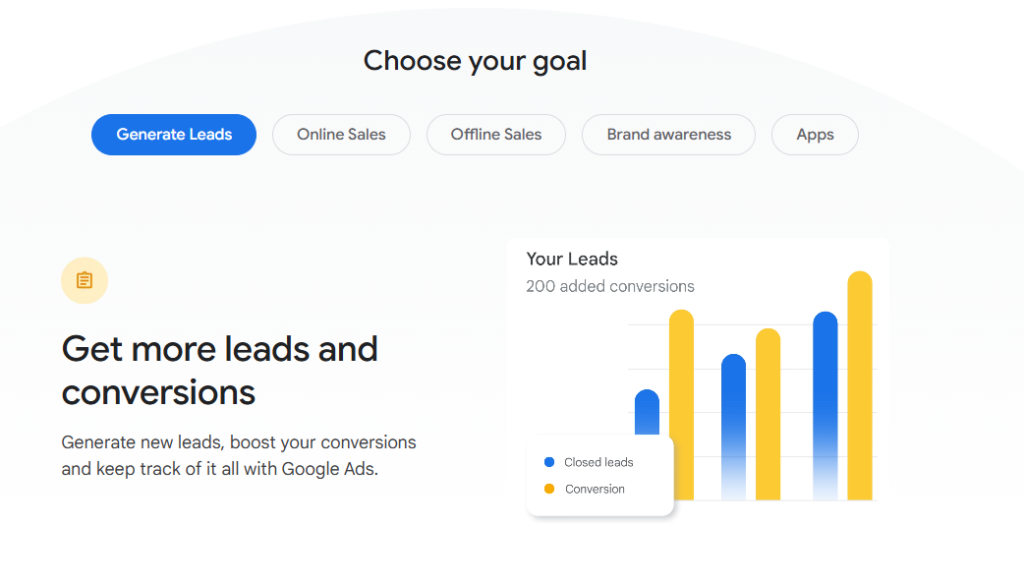Display Ads Google is an essential part as part of the digital marketing strategy of B2B SaaS companies. They assist in enhancing brand visibility, increasing qualified traffic, and generating leads. But in order to make sure that your campaigns are successful, you need to familiarize yourself with the various ad sizes that are available and ensure that you are abiding by best practices in the B2B SaaS category.
In this in-depth article, we’ll be going over everything about Google Display Ads sizes, best practices, and tips that are specific to B2B SaaS companies.
Jump to:
Google Display Ads for B2B SaaS
Google Display Ads are graphical ads that show over a wide variety of different websites, mobile apps, and videos in the extensive Google Display Network (GDN). Amplifying the reach of businesses, the GDN (Google Display Network) boasts of 2 million partner websites and can reach over 90 % of internet users globally. They could be image-based, text-based, or interactive formats designed with the intent to grab user attention and engagement while surfing the web.
Google Display Ads is an incredibly powerful advertising medium for B2B SaaS companies looking to build brand awareness in niche professional areas. Because in the B2B space, stakeholders frequently engage in extensive online research before making purchases, display ads can help build brand credibility and keep brands top of mind by maintaining a constant, visible presence. Additionally, these ads are a critical tool for retargeting, helping companies reconnect with users who visited their websites, and explored their offerings, but ultimately did not make a purchase. It does this by ensuring that your brand and your solutions are top of mind for potential buyers as they go through the decision-making lifecycle.

Google Display Ads are more than just a tool for brand awareness and retargeting; they are significantly useful for lead generation efforts as well. To generate high-quality leads, B2B SaaS companies need to drive compelling offers (free trials, downloads, exclusive product demos) on their websites.
For example, these ads can be a powerful promotional channel to express interest in an industry event, webinar, or product launch. As most SaaS companies are led by thought leadership and education as the primary drivers of sales, display ads can serve to supplement that top-level communication; increasing visibility to those initiatives and encouraging participation with these initiatives; resulting in a higher level of engagement with potential clients. With accurate targeting options like demographic filters, contextual targeting, and affinity audiences, B2B SaaS businesses can deliver their message to decision-makers at the right time for maximum impact and return on investment.
What Are the Standard Google Display Ads Sizes?
When it comes to Google Display Ads, using the right sizes is key to creating effective campaigns. While Google encourages various kinds of display ad sizes, some formats might be more successful than others in terms of visibility and engagement.
The most common sizes for Google Display Ads are:
1. Rectangles and Squares
300 × 250 (Medium Rectangle): Among the most popular ad sizes, works great for both desktop and mobile placements.
336 × 280 (Large Rectangle): This size availability will enable better visibility from desktops.
250 × 250 (Square): Best for mobile placements in tight confines.
Four smaller measurement units — 200 × 200 (Small Square): not very frequently used, but quite powerful in specific placements.
2. Leaderboards
728 × 90 (Leaderboard): The most visible of ads, the placement is generally at the top of web pages on desktop.
468 × 60 (Banner): More compact than the leaderboard, it fits better into mid-page locations.
234 × 60 (Half Banner): A space-saving choice for smaller areas.
3. Skyscrapers
120 × 600 (Skyscraper): Vertical ad spaces ideal for sidebar placement.
160 × 600 (Wide Skyscraper): More visible than a regular skyscraper.
300 × 600 (Half Page Ad): A large ad size and one of the most effective for gaining attention.
4. Mobile-Specific Sizes
Mobile Banner (320 × 50): Most popular for mobile devices.
320 × 100 (Large Mobile Banner): Twice the height of a standard mobile banner
250 × 50 (Mobile Small Banner) Useful for apps and smaller mobile screen
5. Other Common Sizes
970 × 90 (Large Leaderboard): Very good for large screens or desktop devices.
970 × 250 (Billboard): Ensures maximum visual impact.
300 × 1050 (Portrait): A Premium position on these high-quality sites.
Why Are Ad Sizes Important for B2B SaaS Campaigns?
The sizes of the ads at the same time dictate where an ad will be shown and how will they appear before the users. For B2B SaaS companies, one way to get better reach is to choose the right ad sizes as larger and more common ad sizes mean your ad will most likely be shown across a wider range of sites. This even improves engagement, because well-proportioned ad creative, of high quality, is more likely to capture the attention of decision-makers. Cost-effectiveness can also be enhanced by optimizing to serve the most appropriate ad sizes, ultimately producing better click-through rates (CTR), and decreased cost-per-click (CPC).
What Are Common Mistakes to Avoid in Google Display Ads for B2B SaaS?
Below are a few frequent missteps to avoid:
Too Much Information in Ads: Be brief in Your Ad Copy. If you throw too much information to the users, they will drown.
Missing Frequency Capping: Frequency capping is important to ensure that you do not bombard a user with the same ad repetitive times.
Not Optimizing the Landing Page: It is important to have your landing page optimized for submissions. Edit Your Picture Neglecting Your Landing Page Optimization Make sure that your landing page is optimized to take on conversions and provide a smooth transition from the ad click to the action.
Ignoring Conversion Tracking: While clicks are important, remember to focus on the end goal—conversions. Leverage their contributions to your campaigns.
What Are the Best Practices for Google Display Ads in B2B SaaS?
Google Display Ads for B2B SaaS campaigns must focus on correct audience targeting and designing an unbeatable value proposition, and use good visuals too. Many B2B SaaS products serve niche markets that face specific pain points, making accurate audience targeting essential. You can create custom intent audiences based on relevant keywords and URLs, and affinity audiences enable you to target only the users who are searching for things related to your site based on interest and browsing behavior. Use: Remarketing Remarketing is the best way to reconnect with users who have previously engaged with your website or app.
Your ad should promise and explain its value proposition. Highlighting unique features and formatting your copy in a benefit-driven manner where you demonstrate how your unique solution solves a particular problem goes a long way in setting you apart. Free trials, demos, or downloadable whitepapers can further engage the potential customer with that advertisement. Visual components are very important, hence the use of professional, clean designs with little clutter. Use brand colors and logos for consistency, and add images or icons relevant to the tech nature of your SaaS solution.
You need an engaging call to action (CTA) to bring in conversions. Calls to action such as Request a Demo, Start Your Free Trial, and Download Our Whitepaper need to pop by way of different colors and clear language. Furthermore, mobile optimization if done right might help you convert users with mobile clicks which account for a large part of web traffic. Both mobile-specific ad sizes and testing the ad experience on desktop and mobile platforms.
Experimenting with the different sizes and designs of your ad copy can help you decide on the best-performing variant using A/B testing. By keeping an eye on metrics like CTR, CPC, conversion rate, and impressions, you can make sure that you can assess your potential campaigns and fine-tune them accordingly regularly.
How Can B2B SaaS Companies Improve CTR for Google Display Ads?
CTR optimization is essential to maximize the overall performance of Google Display Ads campaigns. Dynamic remarketing can improve CTR for B2B SaaS businesses: By displaying personalized ads based on a user’s prior engagement with your website, you will boost CTR. Ad extensions are also a powerful way to include more details like site links or call buttons. HTML5 allows ads to be more interactive and attractive with engaging animations. By segmenting campaigns by different buyer personas or stages of the sales funnel, you will allow your ads to be relevant and appealing to the right audience.
How does Google display ads retargeting work?
One of the most successful B2B SaaS marketing strategies is retargeting Retargeting enables companies to get back in touch with users who had visited the website but had not purchased. Retargeting requires businesses to set up the Google Ads remarketing tag on their site. After being installed, remarketing lists can be created based on user activity, such as viewing certain pages (e.g. pricing page) or not completing the sign-up process for the free trial. For each segment, you can create personalized ads with special enticements, such as a discount on the first month or a free consultation that would prompt users to follow through with completing the desired action.
Benefits of Google Display Ads
Wide-Reaching Capacity:
Makes use of the Google Display Network, which contains billions of sites, apps, and videos.
Enables SaaS companies to deliver consistent visibility to a broad and niche audience at every stage of the customer journey.
Improved Brand Visibility & Recognition:
A must-have feature to remain competitive in hyper-competitive markets.
But display ads maintain the company’s top of mind, improving brand recall, and building trust over time.
Top of the Funnel Awareness Building:
Instead of focusing on intent like search ads, display ads allow you to reach potential clients with your brand upfront.
Creates awareness before the clients recognize the requirement of the product.
Targeted User Engagement:
More advanced targeting options like custom intent audiences and contextual targeting.
Sends targeted users to designated SaaS website landing pages for demos, white papers, or webinars.
Driving Traffic to Content:
It embeds messages in content people are already consuming.
Directing traffic to blog posts, eBooks, or industry reports, helping to enhance engagement and signups for events.
How To Increase Engagement & Conversions In The Long Term:
Intelligent marketing campaigns and exciting creatives built for long-term interest and conversion.
Drives ROI through various marketing channels.
Accelerating Lead Generation:
Claim a competitive edge with Google Display Ads in this regard, with a faster brand exposure and lead generation process.
Great fit for B2B SaaS businesses looking to solidify their position in the market.

Get Some Help With Your Google Display Ads
Being focused on Google Display Ads campaigns, Ad Labz can help you build a noticeable presence in a high-competition zone as B2B SaaS companies require. We handle the whole process—from ad design to targeting strategies to campaign optimization—for you with our professional team of digital marketing experts. At Ad Labz, we help you save time, improve efficiency , and reduce cost per acquisition. We will help you kickstart your display ad campaigns!
Conclusion
Google Display Ads have huge potential for B2B SaaS companies aiming to influence the audience they want to target, raise brand awareness, and maximize conversions. The right ad sizes, targeting options, and best practices will leverage highly effective campaigns that deliver measurable results. Keep in mind that constant testing and optimization are the keys to long-term success. Focus on continuously optimizing your techniques, staying abreast of new Google Ads launches, and ensuring that your campaigns integrate with your larger marketing strategy. When executed strategically, Google Display Ads can turn into an effective growth engine for your B2B SaaS business.
You might also be interested:


